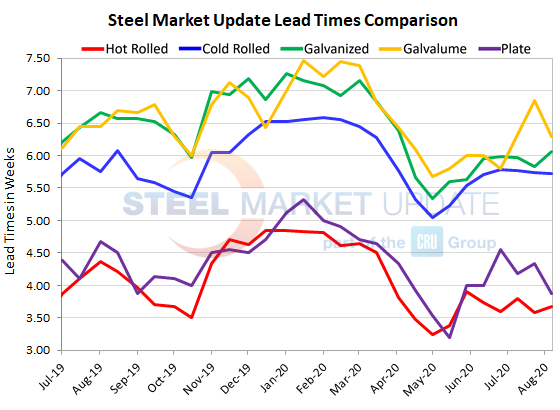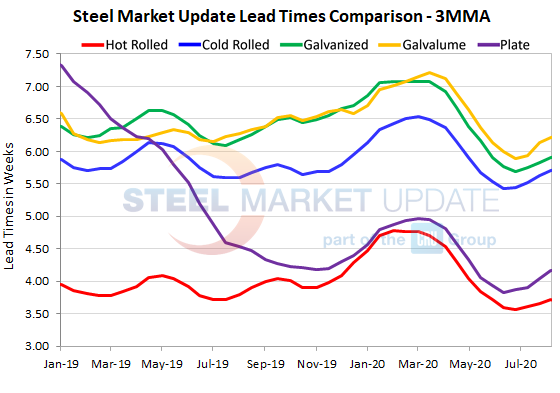SMU Data and Models

Steel Mill Lead Times: Gradually Recovering from the Trough
Written by Tim Triplett
August 6, 2020
Lead times for spot orders of flat rolled steel from the mills were at their shortest in the week of April 30 as orders dried up due to the coronavirus. Since then lead times have extended by about half a week, but saw only minor fluctuations in June and July. Currently, lead times for hot rolled and plate steels are less than four weeks, while lead times for cold rolled and coated are approximately six weeks. Lead times are an indicator of steel demand—shorter lead times indicate the mills are less busy and more inclined to negotiate on prices.
According to Steel Market Update’s check of the market this week, hot rolled lead times now average 3.67 weeks. That’s up from 3.25 weeks at the trough in late April, but down from 4.36 weeks at this time last year.
Cold rolled lead times are virtually unchanged over the past two months at 5.72 weeks. That’s up from a low of 5.04 weeks in April, and comparable to lead times in early August 2019.
Galvanized lead times have extended to 6.06 weeks from the April low point of 5.34. Last August, galvanized orders took 6.67 weeks for delivery, on average. The current average Galvalume lead time is 6.29 weeks, about the same as last year.
Plate lead times bottomed at 3.20 weeks in mid-May and ranged from 4.0 to 4.5 weeks for most of June and July. The latest reading, at 3.88 weeks, is down from 4.33 registered two weeks ago, which suggests the plate mills are slightly less busy.
Looking at three-month moving averages, which smooth out the variability in the biweekly readings, lead times for flat rolled and plate have been inching upward for the past month. The current 3MMA for hot rolled is 3.71 weeks, cold rolled is 5.71 weeks, galvanized is 5.90 weeks, Galvalume is 6.21 weeks and plate is 4.16 weeks.
Note: These lead times are based on the average from manufacturers and steel service centers who participated in this week’s SMU market trends analysis. Our lead times do not predict what any individual may get from any specific mill supplier. Look to your mill rep for actual lead times. Our lead times are meant only to identify trends and changes in the marketplace. To see an interactive history of our Steel Mill Lead Times data, visit our website here.



Tim Triplett
Read more from Tim TriplettLatest in SMU Data and Models

SMU’s June at a glance
A look at SMU data for the month of June.

SMU Survey: Buyers’ Sentiment rebounds from multi-year low
Both of SMU’s Steel Buyers’ Sentiment Indices edged higher this week. Current Sentiment rebounded from a near five-year low, while Future Sentiment rose to a two-month high

SMU flat-rolled market survey results now available
SMU’s latest steel buyers market survey results are now available on our website to all premium members.

SMU Survey: Sheet lead times pull back after early-June blip, plate holds
Following the uptick seen two weeks ago, lead times eased this week for all four sheet products tracked by SMU, while plate lead times held steady, according to this week’s market survey.

SMU Survey: Pricing power abruptly shifts to steel buyers
The majority of steel buyers responding to our latest market survey say domestic mills are more willing to talk price on sheet and plate products than they were earlier this month. Sheet negotiation rates rebounded across the board compared to early June, while our plate negotiation rate hit a full 100%.
